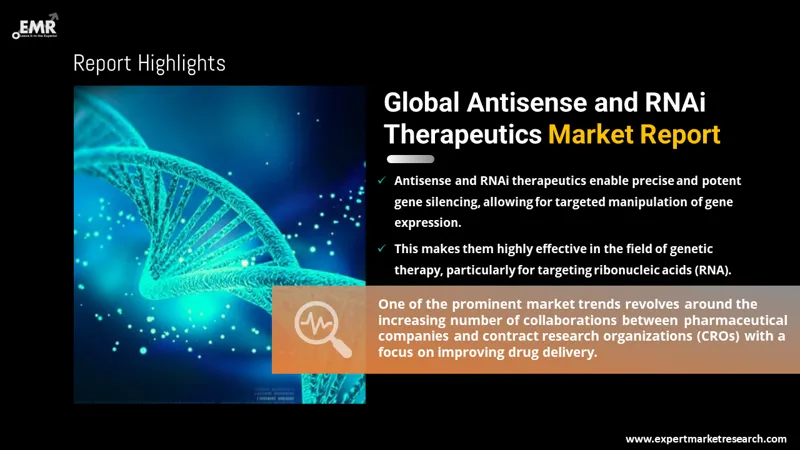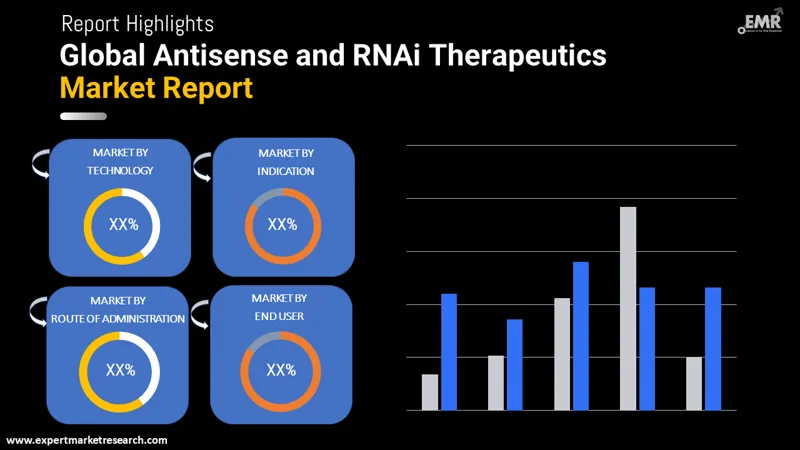
Consumer Insights
Uncover trends and behaviors shaping consumer choices today
Procurement Insights
Optimize your sourcing strategy with key market data
Industry Stats
Stay ahead with the latest trends and market analysis.
The antisense and RNAi therapeutics market was valued at USD 6.05 Billion in 2025, driven by increasing investments in genetic research and the growing prevalence of genetic disorders. The market is anticipated to grow at a CAGR of 18.70% during the forecast period of 2026-2035, with values likely to reach USD 33.59 Billion by 2035.
Base Year
Historical Period
Forecast Period
Compound Annual Growth Rate
18.7%
Value in USD Billion
2026-2035
*this image is indicative*

Read more about this report - REQUEST FREE SAMPLE COPY IN PDF
“Antisense and RNAi Therapeutics Market Report and Forecast 2026-2035” offers a detailed analysis of the market based on the following segments:
Market Breakup by Technology
Market Breakup by Indication
Market Breakup by Route of Administration
Market Breakup by End User
Market Breakup by Region

Read more about this report - REQUEST FREE SAMPLE COPY IN PDF
The global antisense and RNAi therapeutics industry is being driven by intensive study of gene functioning for disease management, through the use of malfunctioning gene and controlling its gene expression. The market is further driven by various collaborations taking place between pharmaceutical companies and contract research organisations, working to enhance drug delivery.
The report presents a detailed analysis of the following key players in the global antisense and RNAi therapeutics industry, looking into their capacity, market shares, and latest developments like capacity expansions, plant turnarounds, and mergers and acquisitions:
The EMR report gives an in-depth insight into the industry by providing a SWOT analysis as well as an analysis of Porter’s five forces.




*While we strive to always give you current and accurate information, the numbers depicted on the website are indicative and may differ from the actual numbers in the main report. At Expert Market Research, we aim to bring you the latest insights and trends in the market. Using our analyses and forecasts, stakeholders can understand the market dynamics, navigate challenges, and capitalize on opportunities to make data-driven strategic decisions.*
Get in touch with us for a customized solution tailored to your unique requirements and save upto 35%!
The market was valued at USD 6.05 Billion in 2025.
The market is anticipated to grow at a CAGR of 18.70% during the forecast period of 2026-2035, with the values likely to reach USD 33.59 Billion by 2035.
The major industry drivers are intensive study of gene functioning for disease management, through the use of malfunctioning gene, and controlling its gene expression.
The key trends in the market are various collaborations taking place between pharmaceutical companies and contract research organisations, working to enhance drug delivery.
The major regions in the industry are North America, Latin America, the Middle East and Africa, Europe, and the Asia Pacific.
The technology types include RNA interference, siRNA, miRNA, and antisense RNA.
The application sectors include oncology, cardiovascular diseases, respiratory disorders, renal diseases, neurodegenerative disorders, genetic disorders, and infectious diseases, among others.
The routes of administration include pulmonary delivery, intravenous injections, intra-dermal injections, intraperitoneal injections, and topical delivery, among others.
The major players in the industry are OliX Pharmaceuticals Inc., Sanofi S.A, SAN (EPA), GlaxoSmithKline, GSK (LON), Ionis Pharmaceutical, Benitec Biopharma Ltd, Silence Therapeutics Plc, Others.
Explore our key highlights of the report and gain a concise overview of key findings, trends, and actionable insights that will empower your strategic decisions.
| REPORT FEATURES | DETAILS |
| Base Year | 2025 |
| Historical Period | 2019-2025 |
| Forecast Period | 2026-2035 |
| Scope of the Report |
Historical and Forecast Trends, Industry Drivers and Constraints, Historical and Forecast Market Analysis by Segment:
|
| Breakup by Technology |
|
| Breakup by Indication |
|
| Breakup by Route of Administration |
|
| Breakup by End User |
|
| Breakup by Region |
|
| Market Dynamics |
|
| Supplier Landscape |
|
| Companies Covered |
|
Datasheet
One User
USD 3,299
USD 2,969
tax inclusive*
Single User License
One User
USD 5,499
USD 4,949
tax inclusive*
Five User License
Five User
USD 6,999
USD 5,949
tax inclusive*
Corporate License
Unlimited Users
USD 8,199
USD 6,969
tax inclusive*
*Please note that the prices mentioned below are starting prices for each bundle type. Kindly contact our team for further details.*
Flash Bundle
Small Business Bundle
Growth Bundle
Enterprise Bundle
*Please note that the prices mentioned below are starting prices for each bundle type. Kindly contact our team for further details.*
Flash Bundle
Number of Reports: 3
20%
tax inclusive*
Small Business Bundle
Number of Reports: 5
25%
tax inclusive*
Growth Bundle
Number of Reports: 8
30%
tax inclusive*
Enterprise Bundle
Number of Reports: 10
35%
tax inclusive*
How To Order

Select License Type
Choose the right license for your needs and access rights.

Click on ‘Buy Now’
Add the report to your cart with one click and proceed to register.

Select Mode of Payment
Choose a payment option for a secure checkout. You will be redirected accordingly.
Gain insights to stay ahead and seize opportunities.

Get insights & trends for a competitive edge.

Track prices with detailed trend reports.

Analyse trade data for supply chain insights.

Leverage cost reports for smart savings

Enhance supply chain with partnerships.

Connect For More Information
Our expert team of analysts will offer full support and resolve any queries regarding the report, before and after the purchase.
Our expert team of analysts will offer full support and resolve any queries regarding the report, before and after the purchase.
We employ meticulous research methods, blending advanced analytics and expert insights to deliver accurate, actionable industry intelligence, staying ahead of competitors.
Our skilled analysts offer unparalleled competitive advantage with detailed insights on current and emerging markets, ensuring your strategic edge.
We offer an in-depth yet simplified presentation of industry insights and analysis to meet your specific requirements effectively.
Share